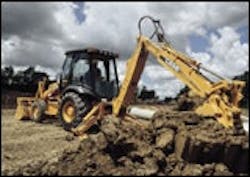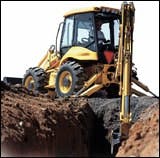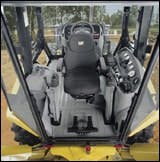Backhoe Battles Sweeten the Selection
|
|
|
|
- Ingersoll Equipment
- JCB
- John Deere
- Bobcat
- Kubota
- Waldon
- New Holland Construction
- Allmand
- Volvo
- Terramite
- Case
- Terex
- Ingersoll Rand
- Caterpillar
- Komatsu
- Hydraulic wars
- Grab for control
- Cabs: A battle of inches
- Basic Specifications
Because of backhoe-loaders' unprecedented popularity (the skid-steer is the only construction machine that represents as many sales), manufacturers struggle to distinguish themselves with an amazing variety of hydraulic systems, loader and backhoe capacities, drive systems, and cab features.
Many equipment manufacturers have come to believe that in order to satisfy their dealers' need for a backhoe-loader, and prevent them from filling the hole in their product line with a competitive nameplate, they must have a backhoe-loader. This kind of thinking has enticed Komatsu, Terex, and most recently Volvo to compete in North America's largest machine category. Competition of this caliber is important because it virtually guarantees there's a backhoe-loader with just the right specifications and features for any job.
Every one of the most recent entrants to the backhoe-loader competition has differentiated itself from the market leaders by offering machines with closed-center hydraulic systems (that's Komatsu, Terex, Volvo, and even Caterpillar, which led the assault on the kings of the backhoe hill way back in the 1980s).
Open-center hydraulics — which remain standard on Case, JCB, New Holland, and the most-important 14-foot-class Deere machines — claim to improve the operator's ability to "feel" the trench in fine-control situations. When you're digging close to buried obstacles such as utility lines crossing the trench and the control levers are only partially engaged, you get steady hydraulic pressure to the boom, stick and bucket cylinders. The open-center system's pump (typically a fixed-displacement gear pump) pushes the same amount of oil into the system as if the operator were booming up and swinging at full speed. The excess oil flow returns to the hydraulic reservoir through a relief valve that maintains constant system pressure.
When the bucket bumps into something unusually hard, like a pipe, experienced operators say they can feel through the control levers the momentary pressure spike created when resistance to the bucket's progress suddenly increases, but the relief valve hasn't yet cracked open enough to dump the oil overflow to the tank.
Closed-center hydraulic systems typically rely on a variable-displacement piston pump that can push more hydraulic flow in response to changes in system demand. The design is productive because it increases flow through the system for faster cycle times when you're using several functions at once (like when you're coming out of the hole using boom up, stick out, bucket dump, and swinging all at the same time). It improves fuel efficiency when the machine is sitting at idle because the pump can stop pushing oil completely. And the pump can vary its flow in an infinite range down to zero when you're slowly moving a couple of functions.
But operators schooled in what has been an all-open-center world tend to say closed-center systems soak up the pressure spikes when they're exercising fine control. They find it harder to feel the buried utilities.
Times may be changing, though. One category stalwart, John Deere, has incorporated closed-center and variable pumps in its 16-foot 410G. If manufacturers start putting engines with electronic fuel injection into backhoe-loaders, it's possible we'll see more piston pumps. If buyers push for fuel efficiency, manufacturers will be able to make fuel-injection controllers communicate with the brain on variable piston pumps like they do on excavators.
But the underground world where backhoe-loaders work is increasingly crowded with expensive utility lines. Operators will resist closed-center systems if they perceive them to sacrifice fine-control feel for efficiency. For this reason, Case continues to tout "feel" as a competitive advantage.
Most backhoe combatants are evaluating servo-hydraulic backhoe controls like those that Cat made standard equipment on the 420D and 430D late last year. JCB offers the excavator style, electronic-over-hydraulic joysticks as an option on its larger 2002 models, but Cat claims to be gaining market share courtesy of its clear commitment to the technology.
Joysticks require less effort to use and can be built into the seat's armrests, allowing operators to sit more comfortably and making them more productive for longer shifts. High-volume 14- and 15-foot machines that come with electronic-joystick controls are probably training buyers to expect the feature on high-spec machines. It seems only a matter of time before Komatsu adds servo controls to its excavator-like hydraulic system, and Deere has a decent match for joysticks in the closed-center hydraulics on the 410G.
Manufacturers that market machines with four-wheel drive, four-wheel steering modes, and four equal-sized tires (JCB, Komatsu, New Holland, Ingersoll Rand, Bobcat) say users who try the machines stick with them. The features are attractive to those who do more than the average amount of loader work because being able to crab steer, or make both front and rear wheels cooperate in a tight turn, makes the loader more maneuverable.
It's a small niche, estimated at significantly less than 10 percent of the total number of backhoe-loaders sold every year. All-wheel steer is important enough, though, that traditionally tight-lipped Caterpillar is hinting that it will soon add the feature to its line.
The backhoe-loader is all about versatility, and the brace of available attachments continues to expand the machine's utility. Quick-attach couplers for fast bucket or attachment changes abound. Caterpillar's integrated-toolcarrier version aims to refine the backhoe-loader's ability to wield attachments. The most apparent features are parallel-lift loader arms, designed to hold the load level up through the lift arc to full height for safe pallet-fork work. Powerful auxiliary hydraulics are plumbed conveniently to both working ends of the machine.
Most competitors have made some form of parallel-lift standard. And many have upgraded their auxiliary hydraulic circuits.
Backhoe-loaders' glass areas continue to grow in 10- and 15-percent increments with each new model. Grab handles and steps keep getting larger and safer. A lot of effort is focused on increasing the amount of clear floor space and making it easier to swivel from the loader controls to the backhoe position.
Creature comforts are multiplying like cup holders in a minivan. Automotive air-conditioning systems are giving way to tougher components designed to handle off-road pounding, and the rigors of cooling a glass booth in sun-scorched environments. Heated, air-ride seats with adjustable lumbar support like those found in long-haul trucks are becoming easier to get in a backhoe cab. Twelve-volt outlets for charging cell phones and other toys are common. If you can't afford the luxurious options, choose the ROPS models that every manufacturer offers.
The breadth of choices makes shopping for a 21st Century backhoe-loader a buyer's dream. Who's to say if open-center hydraulics are better than closed-center, if servo joysticks are better than pilot-hydraulic levers, or if all-wheel steer or an integrated toolcarrier is necessary? Those questions have different answers for different jobs. Whatever you need, it's very likely that somebody offers it.
| Manufacturer Websites | ||
| Allmand Bros. - www.allmand.com | Bobcat - www.bobcat.com | |
| Case - www.casece.com | Caterpillar - www.cat.com | |
| Coyote Loaders - www.coyoteloaders.com | Ingersoll Equipment - www.ingersoll-inc.com | |
| Ingersoll Rand - www.irco.com | JCB - www.jcbna.com | |
| John Deere - www.deere.com | Komatsu - www.komatsuutility.com | |
| Kubota - www.kubota.com | Massey Ferguson - www.masseyferguson.com | |
| New Holland - www.newhollandconstruction.com | Terex - www.terex-tlb.com | |
| Terramite - www.terramite.com | Volvo - www.volvoce.com | |
| Waldon Lay-Mor - www.mobileproductsinc.com | ||
| *Source: "Contractors' Equipment Cost Guide," published by Equipment Watch; telephone: 800/669-3282. | ||



